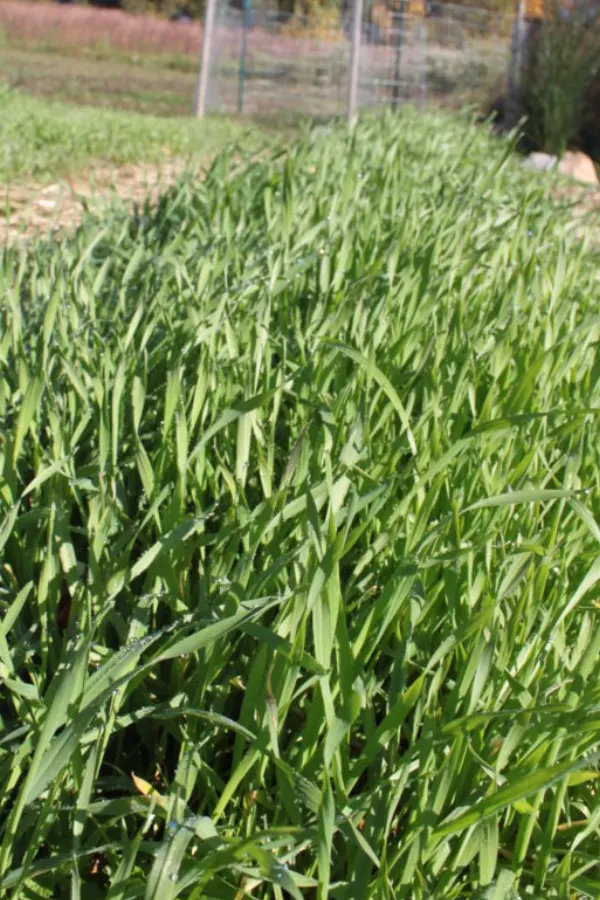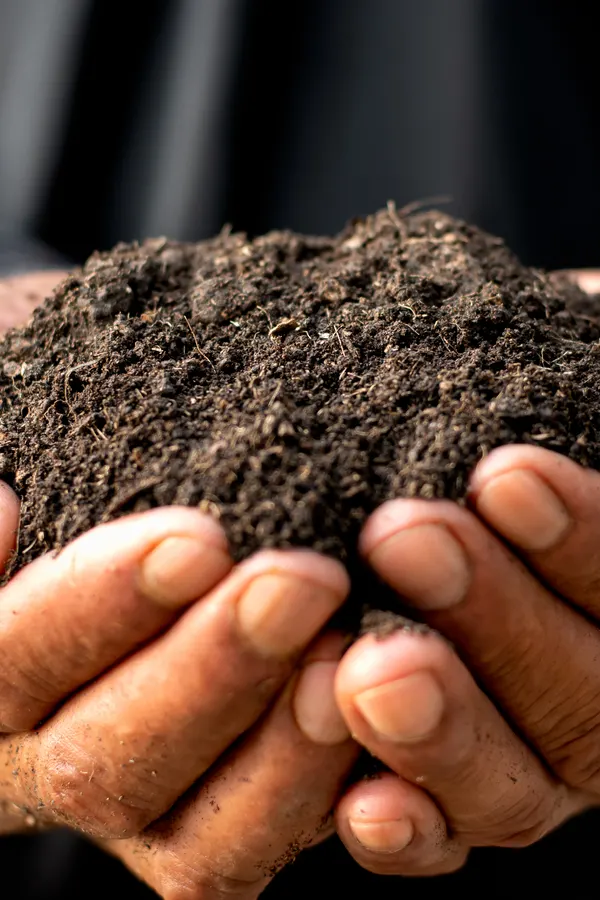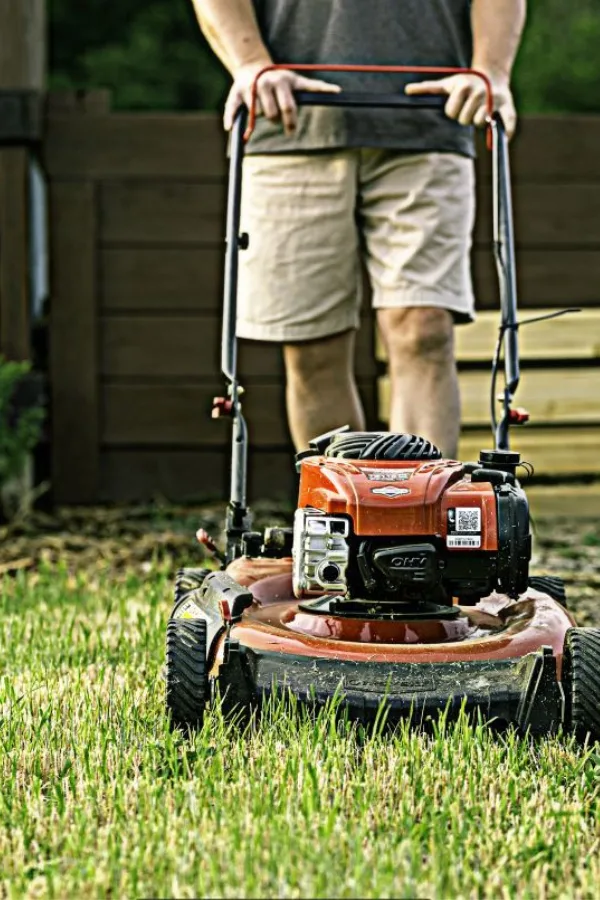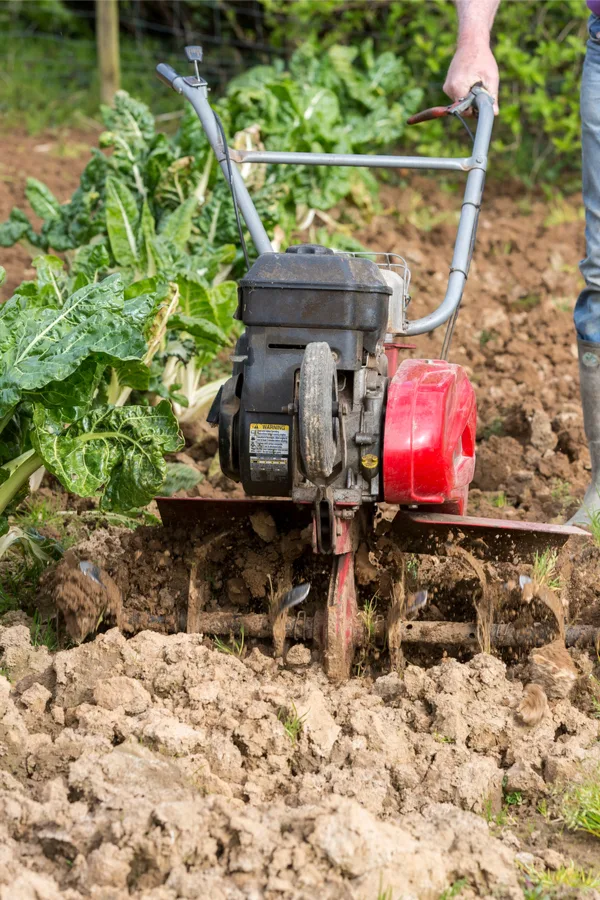When it comes to creating a great low-maintenance garden, nothing will help more to power your soil, stop weeds, and grow healthier and more productive plants than planting a no-till cover crop in your garden this fall!
And as if that wasn’t enough, it’s one of the easiest gardening chores you will ever perform. Even better, as you’ll see below, you don’t even have to ever till it in!
Every fall, as our summer garden plants begins to fade, we plant the soil of our Raised Row garden with a thick cover crop of annual (cereal) rye. Although there are many cover crops that work well for a garden, annual rye is by far our favorite. And for good reason!

Annual rye quickly fills our garden’s soil with a lush, protective, carpet of greenery. And that thick carpet of grass-like foliage helps in more ways than you would ever think.
The Power Of Planting A Cover Crop
For starters, a cover crops protects your garden from losing valuable soil. When left bare, the soil in a garden can quickly erode away from harsh winter winds, rain, sleet and snow.
Even more, a cover crop helps in preventing next year’s weeds in the garden. By covering the barren soil with lush growth, it shields the garden from weed seeds blowing and drifting in. Seeds that then lie in wait to become next year’s weeding woes!
But that thick, luscious green coat also snuffs out weeds that might be growing, or try to grow this fall. And in the process, it ends the cycle of fall weeds taking over a garden before winter.
Putting Power Back In Your Soil – How To Plant A Fall Cover Crop
But perhaps best of all, a cover crop rejuvenates and revitalizes your garden’s tired soil. A garden loses a tremendous amount of nutrients each growing season as it gives its energy to growing vegetable plants.
If that energy is not replaced, next year’s garden will ultimately suffer. And that is exactly where cover crops come into play!
Cover crops such as annual rye act as the ultimate organic fertilizer for the garden. First, their roots drive deep through the soil, loosening and aerating the dirt as they expand.

Even better, when using a cover crop such as annual rye, the roots also help to fix nitrogen levels in the soil. In doing so, next year’s crops can readily take in this much needed nutrient to help power their growth.
Finally, as the cover crop dies off and the foliage and roots break down, it adds valuable nutrients and organic matter to the soil. In the end, it leaves your garden refreshed and recharged – and ready to grow next year’s crops like crazy!
The Benefits Of Planting A No-Till Cover Crop
One of the best benefits about planting a fall cover crop in your garden is that there is absolutely no need to till it in next Spring.
When planting annual rye, you can simple mow it down a few times in the spring until it dies off – and then plant right through the undisturbed surface below. ( See: How To Plant Annual Rye – The Ultimate Cover Crop)
For transplant crops, we use a post hole digger to quickly create our planting holes. For seed crops, a mattock or pick makes quick work of creating a planting row.

By using the no-till method, it means there is no messing around with a rototiller or garden plow. In addition, there is no waiting for spring rains to stop so you can work the soil. (Product Links: 5 Lb. Bag Annual Cereal Rye Seed – 25LB Bag Annual Cereal Rye Seed)
And more importantly, it means not disturbing the dirt in the garden to allow new weed seeds to find a home. All in all, it allows you to create the ultimate low-maintenance, high-powered garden!
Why Not Tilling Makes All The Difference
Not having to till your garden is more than just a time and labor saver. It also actually helps keeps soil healthier and stronger.
Too much tilling can lead to poor soil structure. It also can wreak havoc on the populations of earthworms and beneficial organisms that lie below the surface.
But more than anything, by not tilling, it will cut your weeding chores to near zero. Every time garden soil is turned over, the weed seeds on top are getting replanted. Don’t disturb the soil, and those weeds never find a home.

Just stop and think about what happens to soil within days of tilling. The freshly dug earth explodes in a heavy population of sprouting weeds.
So what do you do? You till again…and again…and again. All the while, the weeds multiply, and the soil structure disintegrates even more.
With no-till garden cover crops, those endless chores are eliminated. As are 99 percent of the weeds. It really is gardening made simple. And all of these benefits are made even better when you realize just how easy it is to plant a fall cover crop!
How To Plant A Fall Cover Crop
Planting a fall cover crop couldn’t be easier. There is no need to till prior to planting. Actually, there is no need for any hard labor at all!
Check out our Podcast below on How To Plant A Cover Crop!
Simply start by raking each row lightly stir up the soil surface. Next, cast your seeds over the bare soil much like you would plant grass seed. As for how much seed to sow, we scatter about 1/2 to 1 pound of annual rye seed for every 40 square feet of garden space.
To finish, simply lightly rake the soil to set the seed a bit for germinating. There is no need to fully cover the seed. Just cover with a light 1/2 inch layer of straw, and wait for the magic to happen!
Within 7 to 10 days, your fall cover crop will sprout and come to life. And you will be well on your way to protecting and energizing your soil for a great garden next year!
Make this the year you power up your garden with a cover crop. And in the process, have your best garden ever next year! Happy Gardening – Jim and Mary.
Check Out Our Latest Garden Podcast:
Jim and Mary Competti have been writing gardening, DIY and recipe articles and books for over 15 years from their 46 acre Ohio farm. The two are frequent speakers on all things gardening and love to travel in their spare time.
As always, feel free to email us at thefarm@owgarden.com with comments, questions, or to simply say hello! You can sign up for our free email list in the subscribe now box in the middle of this article. Follow us on Facebook here : OWG Facebook. This article may contain affiliate links.
